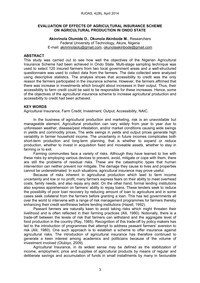EVALUATION OF EFFECTS OF AGRICULTURAL INSURANCE SCHEME ON AGRICULTURAL PRODUCTION IN ONDO STATE
Покупка
Основная коллекция
Издательство:
Редакция журнала RJOAS
Год издания: 2014
Кол-во страниц: 6
Дополнительно
Скопировать запись
Фрагмент текстового слоя документа размещен для индексирующих роботов
RJOAS, 4(28), April 2014
EVALUATION OF EFFECTS OF AGRICULTURAL INSURANCE SCHEME ON AGRICULTURAL PRODUCTION IN ONDO STATE
Akinrinola Olumide O., Okunola Akinbode M., Researchers Federal University of Technology, Akure, Nigeria
E-mail: akinrinolaolu@gmail.com, okunolaakinbode@gmail.com
ABSTRACT
This study was carried out to see how well the objectives of the Nigerian Agricultural Insurance Scheme had been achieved in Ondo State. Multi-stage sampling technique was used to select 120 insured farmers from two local government areas and a well-structured questionnaire was used to collect data from the farmers. The data collected were analyzed using descriptive statistics. The analysis shows that accessibility to credit was the only reason the farmers participated in the insurance scheme. However, the farmers affirmed that there was increase in investments which brought about increases in their output. Thus, their accessibility to farm credit could be said to be responsible for these increases. Hence, some of the objectives of the agricultural insurance scheme to increase agricultural production and accessibility to credit had been achieved.
KEY WORDS
Agricultural Insurance; Farm Credit; Investment; Output; Accessibility; NAIC.
In the business of agricultural production and marketing, risk is an unavoidable but manageable element. Agricultural production can vary widely from year to year due to unforeseen weather, disease/pest infestation, and/or market conditions causing wide swings in yields and commodity prices. The wide swings in yields and output prices generate high variability in farmer household income. The uncertainty in future incomes complicates both short-term production and long-term planning, that is whether to expand or reduce production, whether to invest in acquisition fixed and moveable assets, whether to stay in farming or to exit.
Farming communities face a variety of risks. Although they have learned to live with these risks by employing various devices to prevent, avoid, mitigate or cope with them, there are still the problems of residual risks. These are the catastrophic types that human intervention can neither prevent nor mitigate. The damage they cause to lives and properties cannot be underestimated. In such situations, agricultural insurance may prove useful.
Because of risks inherent in agricultural production which lead to farm income uncertainty and low or no profit, many farmers express fears on their ability to meet overhead costs, family needs, and also repay any debt. On the other hand, formal lending institutions also express apprehension on farmers’ ability to repay loans. These lenders seek to reduce the possibility of poor loan recovery by reducing amount of loan to agriculture and in some cases seek collateral from the farmers before granting a loan. This has led governments all over the world to intervene with a range of risk management programmes for farmers thereby enhancing their credit worthiness before lending institutions (Hazell, 1992).
Peasant farmers are naturally keen to avoid taking risks which might threaten their livelihood and is often reflected in their farming practices (Alli, 1980). Notionally, there is a trade-off between the levels of risk that farmers can withstand and the aggregate level of food production in the country (Ray, 1985). Recognition of this trade-off by policy makers has led to the introduction of programmes that attempt to address peasant farmers’ aversion to risk (Alli, 1980). One such approach is to establish a scheme to offer insurance against agricultural risks. The introduction of agricultural insurance has therefore continued to generate a keen interest among academics and politicians because of the volume of investment involved (Olubiyo, 2009).
Agricultural Insurance, in its widest sense may be defined as the stabilization of income, employment, price and supplies of agricultural products by means of regular and deliberate savings and accumulation of funds in small installments by many in favourable
3


